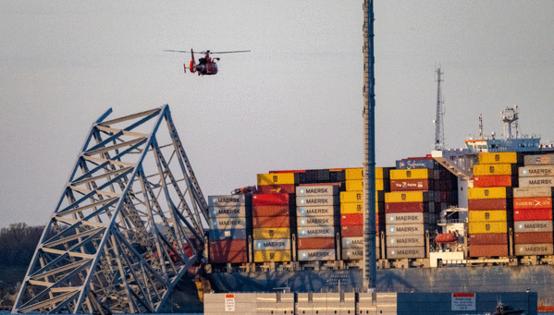NTSB analyzes ship's onboard data for clues to collision that caused collapse of Baltimore's Key Bridge
Published in News & Features
BALTIMORE — Data capturing the moments before the container ship Dali struck the Francis Scott Key Bridge has been secured by the National Transportation Safety Board and is being analyzed by the federal agency’s lab, officials confirmed Wednesday.
Large ships are required by international regulations to carry voyage data recorders that, similar to the “black box” found on aircraft, help investigators piece together key decisions and actions.
If the equipment works properly and the data can be verified, it can provide information that serves as a “road map” of what the ship was doing in the lead-up to a casualty event, said Lawrence Brennan, an adjunct professor with Fordham University’s School of Law who teaches a maritime law course.
The bridge collapsed early Tuesday. Six members of a crew repairing potholes on its deck remained missing Wednesday afternoon in the Patapsco River and were presumed dead. Searchers continued to look underwater for their remains.
Spokespeople for the NTSB did not immediately respond to an inquiry from The Baltimore Sun about the condition of the Dali’s voyage data recorder and whether it properly captured information.
The NTSB’s chair, Jennifer Homendy, said Tuesday the recorder would be “critical” to the investigation.
A media briefing by the agency is scheduled for 8 p.m. Wednesday.
Data items captured by recorders can include the ship’s position, speed, direction, the audio in work stations, communications audio, radar, the depth of the water underneath vessels, the alarms going off, wind speed and an electronic logbook.
In this case, it could provide new details about the conversations taking place between a pilot and crew members, the ship’s movement and, potentially, the “mayday” signal that officials say helped prevent more casualties on the Key Bridge. The local pilot was on board to guide the ship through the harbor.
The data will likely serve as a first step for investigators probing for the reasons why the ship ran into one of the Key Bridge’s piers, causing it to crumble into the Patapsco.
“That’s the primary purpose: Why did the casualty happen?” Brennan said. “Does it range from human error — I doubt it. Is there a mechanical failure? Probably. Are there contributing causes? Is there a failure to respond on the part of the captain or whoever was on the bridge? What could they have done to avoid that?”
Homendy said Wednesday morning that “a few folks” had boarded the vessel Tuesday night and that it was likely NTSB crews would board it again Wednesday.
She said the agency’s focus Wednesday would be “getting on board the vessel, getting the electronic logs or any sort of electronics components that we need to get.” The crews would be seeking “perishable evidence” that would no longer be available when the ship and wreckage was cleared from the waters.
“The focus is: What do we need for our investigation, whether it’s from the vessel or from the highway, from the bridge structure? Identifying those, securing those, before we do any analysis,” Homendy said.
She indicated the agency would also be working on a list of who they hope to interview, both on the vessel and in the immediate vicinity.
_______
(Baltimore Sun reporter Dan Belson contributed to this article.)
_____
©2024 The Baltimore Sun. Visit at baltimoresun.com. Distributed by Tribune Content Agency, LLC.







Comments